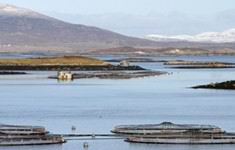 will be seeking to share its fish farming expertise at Aqua Nor 2013, the 18th in the country’s biennial series of aquaculture exhibitions which will be held in Trondheim from 13 to 16 August of this month.
will be seeking to share its fish farming expertise at Aqua Nor 2013, the 18th in the country’s biennial series of aquaculture exhibitions which will be held in Trondheim from 13 to 16 August of this month.“In 2013 the organizers of the exhibition are focusing on making all of Norway’s knowledge and technology available to other countries, applying it to other species and under different climatic conditions,” said Erik Hempel, communications director.
“Around the world, people have ‘discovered’ Norwegian aquaculture and especially aquaculture technology. Many emerging countries want to learn from Norway,” he said.
“Norwegians were relative late comers in the aquaculture industry, and have been active for only 40 to 50 years. But when they started with fish farming, their approach was systematic and serious.
“The focus was on science-based operations and a continuous improvement of technology. Importantly, they also focused on the software side of aquaculture: the scientific basis for operations, management systems, economics, environmental concerns etc.
“Norwegian aquaculture is today a knowledge industry, and this puts demands on operators to be updated and open for innovations in all aspects of the industry.”
At Aqua Nor, owner and organizer the Nor-Fishing Foundation is joining forces with Norway’s Marine Research Institute to show how the technology for farming salmon and trout which has been developed in Norway, can be adapted to other species in other parts of the world.
“The Marine Research Institute has been involved in a number of development projects in tropical regions using Norwegian technology to raise species such as tilapia, cobia, barramundi and pompano,” said Hempel. Not surprisingly, the two organizations want to showcase these experiences at the exhibition in order to maximize sales of this technology around the world.
As part of the focus on innovation, Hempel says that there has been increased interest in the Aqua Nor Innovation Award, which aims to increase efficiency, safety, improved environment and quality in fish farming.
“It is also important that these innovations contribute to more profitable operations,” he said.
Nineteen applications were received from companies in Germany, Denmark, the UK, Chile and Norway. They covered a wide range of subjects from land-based systems, production management and traceability from farmer to consumer, gas-powered vessels, service/workboats, delicing methods, a sewing machine that can mend nets underwater by remote control, to new cages systems and different transport systems for live and dead fish.
“Salmon lice and escapes are important issues for the industry and for the supplier industries,” said Ola Eriksen, director of the Nor-Fishing Foundation. “And several of the applicants have submitted projects that focus on fighting salmon lice, preferably without the use of chemicals.
“There is also increased focus on safeguarding against escapes from farming installations. Both of these issues are central challenges to the fish farming industry as well as the equipment and technology industries.”
Four finalists have been selected and the final decision will be made at the foundation’s board meeting the day before Aqua Nor 2013 gets underway, and the award will be presented on the opening day of the exhibition, Tuesday 13 August.
All indications are that this will be the largest Aqua Nor ever held. “There is increased international interest,” Hempel said. “In 2011 [the last time Aqua Nor was held] visitors from over 60 nations came to Trondheim for the exhibition, and this year it is expected that even more nations will be represented, especially from Asia and South America. But also visitors from Africa and the Middle East are showing interest.”
One can only hope for their sakes that unlike at Nor-Fishing, which is also owned and organized by the Nor Fishing Foundation, papers are presented in, or simultaneously translated into, English. Not that many people understand Norwegian, the language that was used almost exclusively at Nor-Fishing.





